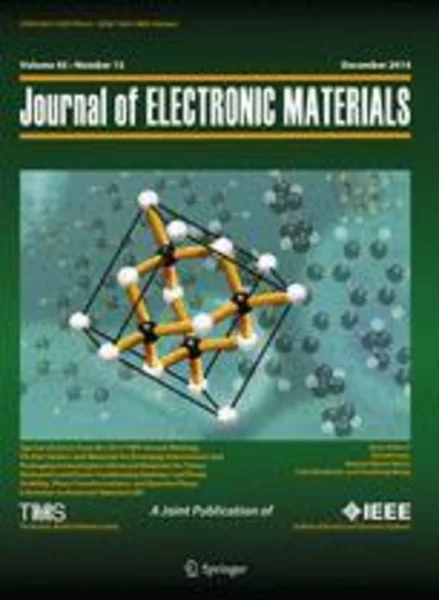-
dielectric and impedance spectroscopy of barium orthoniobate ceramic
جزئیات بیشتر مقاله- تاریخ ارائه: 1392/07/24
- تاریخ انتشار در تی پی بین: 1392/07/24
- تعداد بازدید: 809
- تعداد پرسش و پاسخ ها: 0
- شماره تماس دبیرخانه رویداد: -
barium orthoniobate (ba3nb2o8), a derivative of the perovskite family, was prepared using a high-temperature solid-state reaction technique (calcination temperature = 1425°c and sintering temperature = 1450°c for 4 h). preliminary x-ray structural analysis with room-temperature x-ray diffraction data confirmed the formation of a single-phase compound with hexagonal crystal structure. study of the microstructure of a gold-coated pellet by scanning electron microscopy (sem) showed that the sample has well-defined grains that are distributed uniformly throughout the surface of the sample. detailed studies showed that the dielectric parameters (ε r and tan δ) of the compound at three different frequencies (10 khz, 100 khz, and 1000 khz) are almost constant in the low-temperature region (from room temperature to about 200°c). an anomaly in the relative permittivity (ε r) (∼357°c) suggests the possible existence of a ferroelectric–paraelectric phase transition of diffuse type in the material. detailed studies of impedance and related parameters show that the electrical properties of the material are strongly dependent on temperature, showing good correlation with its microstructure. the bulk resistance (evaluated from impedance studies) is found to decrease with increasing temperature. this shows that the material has negative temperature coefficient of resistance (ntcr), similar to that of semiconductors. studies of electric modulus indicate the presence of a hopping conduction mechanism in the system with nonexponential-type conductivity relaxation. the nature of the variation of the direct-current (dc) conductivity with temperature confirms the arrhenius and ntcr behavior in the material. the alternating-current (ac) conductivity spectra show a typical signature of an ionic conducting system and are found to obey jonscher’s universal power law.
مقالات جدیدترین رویدادها
-
استفاده از تحلیل اهمیت-عملکرد در ارائه الگوی مدیریت خلاقیت سازمانی و ارائه راهکار جهت بهبود
-
بررسی تاثیر ارزش وجوه نقد مازاد بر ساختار سرمایه شرکت های پذیرفته شده در بورس اوراق بهادار تهران
-
بررسی تأثیر سطح افشای ریسک بر قرارداد بدهی شرکت های پذیرفته شده در بورس اوراق بهادار تهران
-
بررسی تأثیر رتبه بندی اعتباری مبتنی بر مدل امتیاز بازار نوظهور بر نقد شوندگی سهام با تأکید بر خصوصی سازی شرکت ها
-
تأثیر آمیخته بازاریابی پوشاک ایرانی بر تصویر ذهنی مشتری پوشاک ایرانی (هاکوپیان)
-
شناسایی آسیب پذیری در اینترنت بانک ، بانک های خصوصی
-
اصلاح شبکه مبدل های حرارتی توسط تکنولوژی پینچ
-
بهره وری و کیفیت زندگی کاری پرستاران اورژانس
-
بررسی اهمیت آثار معماری در انگیزش گردشگران
-
modeling architecture for collaborative virtual objects based on services
مقالات جدیدترین ژورنال ها
-
مدیریت و بررسی افسردگی دانش آموزان دختر مقطع متوسطه دوم در دروان کرونا در شهرستان دزفول
-
مدیریت و بررسی خرد سیاسی در اندیشه ی فردوسی در ادب ایران
-
واکاوی و مدیریت توصیفی قلمدان(جاکلیدی)ضریح در موزه آستان قدس رضوی
-
بررسی تاثیر خلاقیت، دانش و انگیزه کارکنان بر پیشنهادات نوآورانه کارکنان ( مورد مطالعه: هتل های 3 و 4 ستاره استان کرمان)
-
بررسی تاثیر کیفیت سیستم های اطلاعاتی بر تصمیم گیری موفق در شرکتهای تولیدی استان اصفهان (مورد مطالعه: مدیران شرکتهای تولیدی استان اصفهان)
-
بررسی میزان مشارکت مردم در بازسازی بافت فرسوده کلان شهرها مطالعه موردی: خیابان شاهداعی اله شیراز
-
رهیافتی پدیدارشناسانه درزمینه ی عوامل مؤثر بر ارتقاء هویت فردی و ملی دانش آموزان از دیدگاه معلمان
-
بررسی رابطه عملکرد شرکت با موانع ورود به صنعت در شرکت های پذیرفته شده در بورس اوراق بهادار تهران
-
clinical trials versus electrodiagnostic tests (edx) in the diagnosis of carpal tunnel syndrome
-
the effect of glutamine on conductivity and energetic properties in graphene: a dft studies




سوال خود را در مورد این مقاله مطرح نمایید :